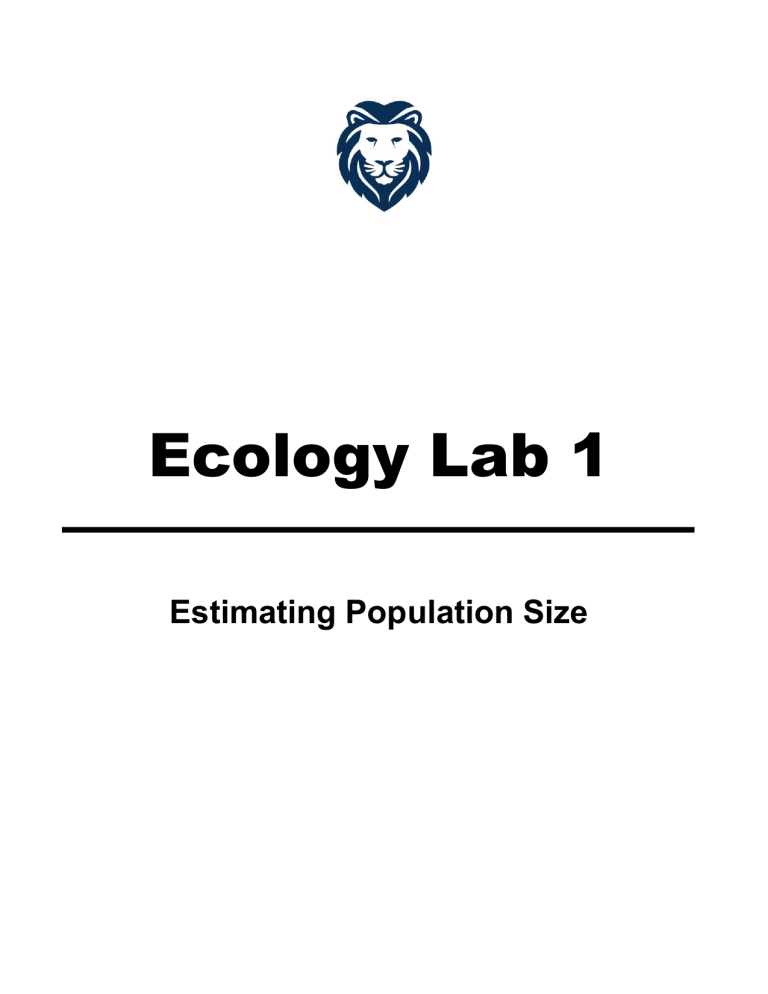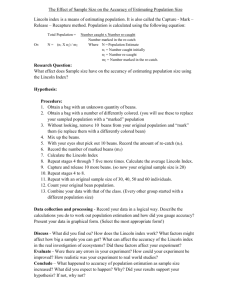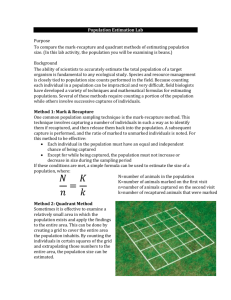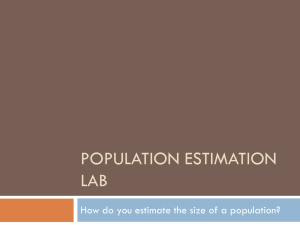
Ecology Lab 1 Estimating Population Size Ecology Lab 1 – Estimating Population Size Background: The ability of scientists to accurately estimate the total population of a target organism is fundamental to any ecological study. Species and resource management is closely tied to population size counts performed in the field. The best way to measure the size of a population is to count all the individuals in that population. When determining the population sizes of trees or other relatively immobile organisms, this method is practical. If the organism is mobile, however, such as a fish, counting every individual would be difficult. Some individuals might be counted twice or not at all, since the experimenter would not know which fish had been counted and which had not. Mark and Recapture Method One common population sampling technique is the mark-recapture. This technique involves capturing a number of individuals in such a way as to identify them if recaptured, and then releasing them back into the population. A subsequent capture is performed, and the ratio of marked to unmarked individuals is noted. Typically, several recaptures are performed. Ultimately the total population of the target species is estimated on the basis of this ratio. The method assumes that the ratio of the actual population to the sample size is the same as the ratio of the number of marked animals to the number marked in the recapture sample. For example, if you capture 1% of the population and mark all of them, then you should expect a second capture to contain 1% marked individuals. Knowing three of the four values [recapture sample size (N2), number originally marked (N1), and number marked in the recapture sample (R)], scientists can calculate an estimate of the actual population size (P). This method of estimation is called the Lincoln Index. The following conditions are assumed to be true in deriving the mathematical formula used to determine the mark-recapture population estimation. Assumptions The Lincoln Index makes several assumptions that must be met if the estimate is to be accurate. These assumptions are: The population of organisms must be closed, with no immigration or emigration. The time between samples must be small compared to life span of the organism being sampled. The marked organisms must mix completely with the rest of the population during the time between the two samples. P = (N1x N2)/R P= total size of population N1= size of first sample (all marked) N2= size of second sample (recapture: some will be marked, some won’t R= number of marked individuals recaptured in second sample Estimating Population Size IN-CLASS ACTIVITY –BEANS Simulate the mark and capture method using beans. MATERIALS: 50 beans, marking pen, plastic container with lid PROCEDURE: 1. Obtain a bag and fill with 50 beans. 2. Mark 20 of the beans with the marker. 3. Place all 50 beans in the bag. Gently shake the bag to mix the beans thoroughly (do not shake too hard or your beans will break apart). Open the bag and without looking withdraw 10 beans. Count the number of marked beans and record in the data table. 4. Put the 10 beans back in the bag and seal it. Shake the bag again and withdraw a second set of 10 beans. Again, record the number of marked beans in the sample in the data table. Continue in this manner until you have completed 10 trials. 5. Estimate the population size for each trial using the Lincoln Index by multiplying the number of beans marked (20) by the number of beans in each sample (10) and dividing the product by the number of marked beans (recaptured) for that trial. The result is an estimation of population size. When you have done this for all 10 trials, find the average by adding the estimates and dividing by 10. WSCC – BIOLOGY 104 Ecology – Lab 1 Estimating Population Size Name:________________________ Date: _________________________ Ecology Lab 1 - Estimating Population Size Trial # # marked beans in sample Population estimate 1. 2. 3. 4. 5. 6. 7. 8. 9. 10. Average:___________________________ __ ANALYSIS: 1. How does the average value compare to the actual population size of 50? 2. If there is a difference, explain what might cause the difference? 3. What problems might scientists encounter in using this method in the field that you would not have encountered in the simulation?




